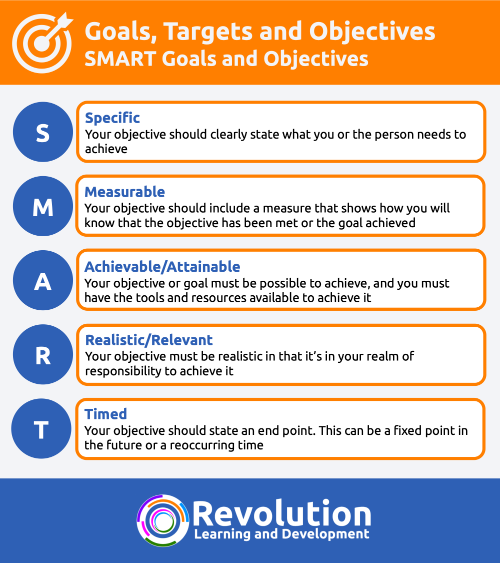Background
In this article, we look at how to set SMART objectives. SMART objectives or SMART goals help make objective and goal setting easy. They ensure your goals and objectives provide clarity and increase your chances of getting more things done.
SMART objectives and goals are a key component of time management, performance management and management & leadership. SMART as a tool is often used incorrectly or used for the wrong things, as not every goal or target can be SMART.
What is SMART?
SMART is an acronym that provides a checklist to ensure objectives and goals are set correctly. SMART stands for:
- Specific
- Measurable
- Achievable
- Realistic
- Timed

Specific
Your objective should clearly state what you or the person needs to achieve. It should include a direction of movement or action, and your objective should describe what needs to be achieved. For example:
- Increase
- Decrease
- Apply
- Change
- Start
- Complete
- Understand
- Improve
Measurable
Your objective should include a measure that shows how you will know the objective has been met or the goal achieved. This measure needs to be tangible, able to be monitored and proof available that the objective has been met or the goal achieved. This could be:
- A KPI (key performance indicator)
- A standard
- A result
- Completion of something
Achievable
The goal or objective must be possible to achieve. Sometimes, you might need to stretch yourself to achieve it, but it should not be impossible.
Realistic
The objective or goal must be realistic in that it is in your realm of responsibility or authority to achieve it. Is it part of your role? Do you have the right authority, responsibility, tools, time and resources to achieve it?
Timed
The objective or goal must have a time of when it will be achieved. This can be a fixed point in the future or a reoccurring time if the objective is a regular task you complete as part of your job.
SMART is essentially a checklist you can apply to an objective you have written to ensure it is all of the above and, therefore a SMART objective or a SMART goal.
One common mistake with SMART objectives and goals is that it is assumed that we should write one statement for each of the 5 points in SMART. This would give us a 5 or more sentence objective. Your objective should be short and succinct while remaining SMART.
A major reason we write SMART objectives and goals is that we want them to be clearly understood. If the objective is too long, it makes the objective too complex.
Examples of SMART Objectives and Goals
Let’s assume for a moment that a chocolate biscuit factory employs us, and we have Tom, one of our team members. Tom’s role is to oversee a machine that produces chocolate biscuits and to check their quality. Tom’s machine can create 100 biscuits each hour it is in operation.
If we set Tom an objective that states:
Produce 100 biscuits per hour.
Is this a SMART objective or goal?
The answer is no. The objective is not specific enough. Tom could essentially allow 100 biscuits to leave his production line and some could be round, some could be square, some could be salty, and some could be sweet, and he still would have achieved his objective. He has essentially made 100 biscuits.
To make this more specific, we need to add more detail:
Produce 100 biscuits to the company recipe and quality standard each hour.
Is this now a SMART objective or goal?
The answer is still probably no. That’s because the objective states that Tom only has to create 100 per hour. It doesn’t stretch him. We could add:
Produce a minimum of 100 biscuits to the company recipe and quality standard each hour.
Is this now a SMART objective or goal?
Yes. We could go a stage further and make this objective specific to Tom:
Tom will produce a minimum of 100 biscuits to the company recipe and quality standard each hour.
In this case, we can’t stretch Tom by increasing the number of biscuits or shortening the time, as Tom’s machine is only supposed to produce around 100 biscuits per hour.
Let’s look at another example.
Let’s say we want to learn conversational Spanish before we travel to the country on holiday next year.
If we set ourselves an objective that states:
Learn to speak Spanish by next year.
Is this a SMART objective or goal?
The answer is no. The objective is not specific enough. We could learn the words Ola and Adios and now state that we can speak Spanish.
To make this more specific, we need to add more detail:
Learn to speak conversational Spanish by this time next year.
Is this now a SMART objective or goal?
The answer is still no. That’s because the problem above still occurs. That’s because the objective or goal is all wrong. We are setting our SMART objective or goal around the wrong thing. The question we need to ask is “how will I know that I can speak Spanish?”. In this case, you could sit an exam. Passing the exam would become your SMART objective or goal. For example:
Pass the level 2 conversation Spanish exam by the 27th of July XXXX.
Is this now a SMART objective or goal?
Yes. We could go a stage further and make this objective specific to us:
I will pass the level 2 conversation Spanish exam by the 27th of July XXXX.
Mistakes With SMART Objectives and Goals
The second example above is a common mistake with SMART objectives and goals. Not everything can be SMART. But, we see many examples where people are forced to make it SMART.
We need to find the measurable in what we are trying to achieve and set our goals and objectives around these things. For example:
I will improve communication in our company by this time next year.
Or
I will increase the levels of motivation in my team by next month.
The above may appear to be SMART objectives or goals, but they are not. How will you measure this? If we are to create SMART objectives or goals around these points, we must look at how we can measure the success of our actions. For example, more motivated employees may mean less sickness or increased performance. Better communication may lead to faster turnaround times.
In these cases, we look to the KPI’s and this is where our SMART objective or goals should be set:
I will reduce the turnaround times of customer orders by a minimum of 1 day by this time next year.
I will reduce sickness absence in my team by 10 per cent by next month
The two original statements become the “how” and not the “what”.
Variations of SMART
There are some variations of the original SMART acronym descriptions.
- A becomes agreed – the objective is an agreement between a manager and team member
- A becomes attainable – often used as a simple change in language
- R becomes relevant – this provides clearer separation between achievable and realistic
Further Learning
If you wish to find out how to set SMART objectives and goals in more detail, you may find a leadership skills training course will help. Take a look at our Leadership Skills Training Course for more details.



